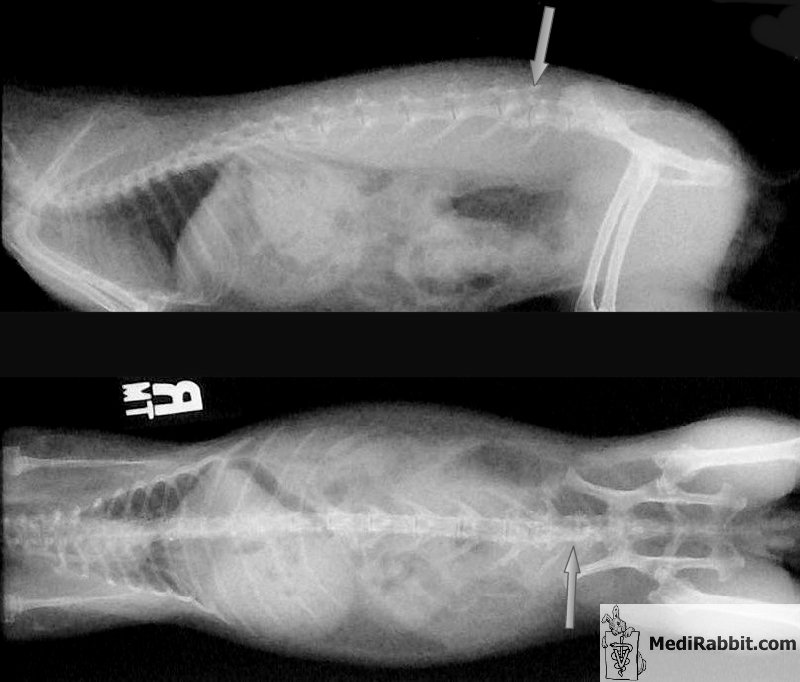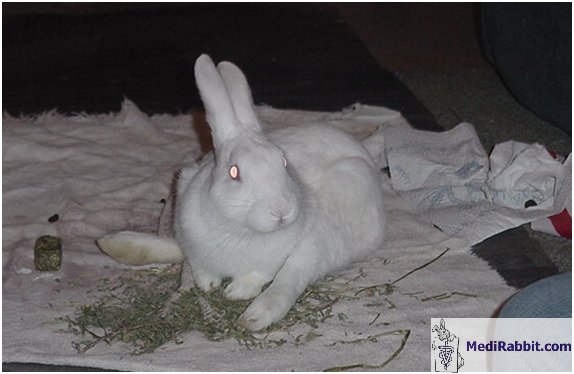Findings on muscular and skeletal
degeneration
in rabbits that lack exercise
Kim Chilson
|
MediRabbit.com is
funded solely by the generosity of donors. Every
donation, no matter what the size, is appreciated and will aid in the
continuing research of medical care and health of rabbits. Thank you |
Warning: this page contains pictures that may
be distressing for some persons.
|
Wild
rabbits are highly athletic creatures that are built to move rapidly in order
to find food, water, find or fight mates, or flee predators over greater
distances to find a hiding place. This daily exercise has been shown to have
a number of benefits, including strengthening the muscles used for movement,
as well as increasing heart and lung function and resistance against stress.
Regular exercise has been proven to strengthen muscles and bones, stimulate
blood circulation, and promoting the proper functioning of organs, such as
the digestive system.
House rabbits are often unable to
develop as fully as their wild counterparts due to their confinement in small
hutches or cages, which limits their exercise and strength-building
abilities. This will inevitably lead to systemic hypoplasia (underdevelopment
of tissues or organs) and the development of physiological, physical and/or
behavioural disorders. Physical disorders include: ·
Overweight. The lack of exercise required to burn calories
and a diet high in fat will inevitably result in weight gain in both female
and male rabbits. The failure to groom properly can result in the development
of ulcerative pododermatitis, cardiovascular problems and skin problems. Physiological disorders include: ·
Gastro-intestinal disorders, e.g. decreased intestine
motility, ·
Cardiovascular disorders, e.g. weak heart muscle, ·
Urinary disorders, e.g. soiling of the perianal region,
paste-like consistence of urine (sludge) or formation of kidney or bladder
stones, ·
Pulmonary disorders, due to cardiovascular problems.
Muscular and skeletal problems In the absence of opportunities for
exercise, the muscle mass of a rabbit will not develop, remaining weak. In
extreme cases, there have been instances where a rabbit has been found to be
unable to develop normal motor coordination or ambulation. The heart is also affected and will
remain weak. Apart from issues related to blood circulation and blood
pressure, a weak heart can also result in complications when a rabbit is
under stress. A wild rabbit that has been well-trained to cope with stressful
situations, such as being chased or hunted, will typically flee over a
greater distance to find shelter. However, a poorly exercised pet rabbit that
is confined in a cage may not be able to cope with the situation and may
faint or die from a cardiac arrest. Furthermore, insufficient physical
activity has been shown to have an impact on the vertebral column. The spine
is composed of three types of muscles that connect the transverse and spinous
processes of each vertebra. These muscles are known as the transversospinal
muscles. The function of these muscles is not yet fully understood, but it is
believed to be involved in local rotations of the vertebral column or
initiate bending. The observation that certain transversospinal muscles
traverse a number of intervertebral joints indicates their potential
involvement in controlling vertebral position and maintaining spinal,
forelimb and hindlimb stability. The spine is furthermore connected to
an intricate system of trunk muscles: ·
extensors, which include the back and gluteal muscles (muscles that form the buttocks.), allowing for instance
hip movement, ·
flexors, which allow the spine to bend, to control the
arch of the lumbar spine, or hip movement, ·
obliques, that stabilize the spine.
Rabbits that are not given sufficient
exercise and/or fed a diet lacking in calcium often exhibit signs of impaired
bone structure and density. This is due to poor mineralisation of the bones.
Weakened bones and those affected by osteoporosis are prone to injury and
fracture. The vertebrae of the spine provide support for the back. If this is
accompanied by poorly developed transversospinalis and trunk muscles, there
can be a number of consequences. These include alterations to the spinal
structure and biomechanics, which can lead to degenerative processes.
Deformations are appearing, which may hinder the development of adequate
locomotive activity. Intrinsic muscle imbalance has been shown to cause
degenerative changes to the lumbar vertebrae and femoral head in rabbits that
do not exercise. These include: ·
hemivertebrae (abnormal
birth defect in which the vertebra fails to develop completely. As a result
of the growth defect of the spine, a wedge-shaped vertebra develops, and
neighboring vertebrae expand or tilt to fit the deformity) ·
spondylosis (a
condition of the spine marked by stiffness of a vertebral joint) ·
kyphosis (humplike
curvature of the spine) ·
lordosis (abnormal,
increased degree of forward curvature of any part of the spine). The severity of the deformations
appears to be dependent on the cage size. Rabbits
suffering from weak muscles and/or poorly mineralised bones and/or bone
degeneration are at increased risk of spine fracture when there is inadequate
support of the heavily muscled hindquarters, walking on a slippery floor, or
twisting of the lumbosacral junction when frightened or restrained. Fracture
is commonly observed at the level of the seventh lumbar vertebra (L7).
Treatment A radiography will confirm the
presence of an injury or fracture, and the degree of severity can be
assessed. It is imperative that each case is evaluated on its own individual
facts and circumstances.
Acknowledgement Thanks are due to Dr B. Langhofer (The Scottsdale Veterinary
Clinic Scottsdale, AZ, USA), and to A. Carpenter for sharing their
pictures. Further information 1. Katherine
E. Quesenberry, James W. Carpenter, Peter Quesenberry Ferrets, Rabbits and Rodents: Clinical Medicine and Surgery
Includes Sugar Gliders and Hedgehogs, Elsevier Health, 2004. 2. Frances Harcourt-Brown Textbook of Rabbit Medicine, Oxford
UK: Butterworth-Heinemann, 2001. 3. Paul Flecknell, editor, BSAVA Manual of Rabbit Medicine and
Surgery Gloucester, UK: British Small Animal Veterinary Association, 2000.
and references therein. |
||||||||||||
e-mail: info@medirabbit.com











